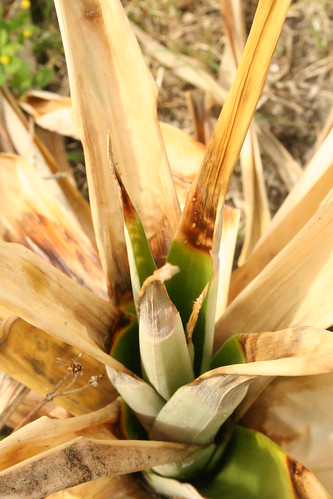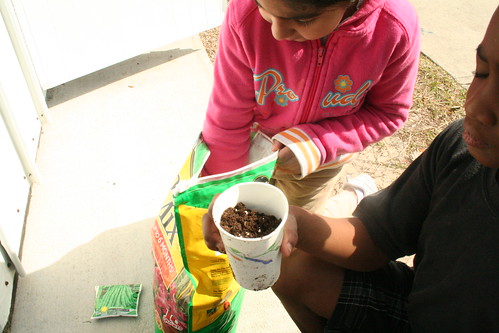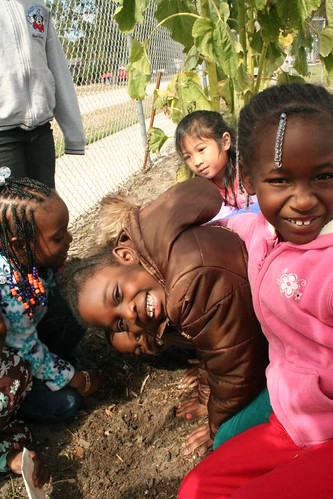Welcome! This blog follows the building, cultivating, and harvesting of the Lakewood Elementary schoolyard garden in St. Petersburg, Florida. Since January 2009, the Edible Peace Patch Project has been developing innovative community-oriented food system and nutrition educational programs in south St. Petersburg, Florida. Lakewood Elementary is the 1st school to participate in our Garden Education Program!
Saturday, February 27, 2010
A Wonderful Weeks End
Thursday, February 25, 2010
A Blustery Day
Our first class was moved inside since today's high was 56 degrees. We worked with K-2nd grade EBD students on identifying similarities and differences of different animals. This was actually wonderful since the class is pretty small and we were able to work one on one with the students. I find that EBD students are actually extremely bright, they just have trouble expressing themselves, so one on one is ideal to really get to know them.

On Thursdays, I've decided to be brave an take on a second shift meaning I work with four classes pretty much one right after another. This experience is truly exhausting. Yet, I want to provide these students with the best learning experience in the garden possible, and when it comes time to leave the garden I leave tired but happy.
 Our afternoon classes also planted marigold seeds, helped weed the mulch, and together we read a book called "The Dandelion Seed". Our first graders were extremely excited to read the book, and even helped us read the book!
Our afternoon classes also planted marigold seeds, helped weed the mulch, and together we read a book called "The Dandelion Seed". Our first graders were extremely excited to read the book, and even helped us read the book!
pigs feet and plant roots?

We had one more class afterwards, a fun group of 5th graders who particularly made me realize the importance of the garden to the children at Lakewood. Emma created a worksheet with sketches of three plants that the students could find in the garden: lettuce, sunflower, and pineapple. We split in to groups and examined the plants, labeling the parts and discussing the function of those parts. The kids determined what plants need to carry out photosynthesis, and discussed similarities between animals and plants (somehow leading to eating pigs feet and hot sauce?).
Overall, it was a great day.. the starters are beginning to sprout, cucumbers are coming up, and the rain held off until we left!

Tuesday, February 23, 2010
The Revolution Will be Gardenized
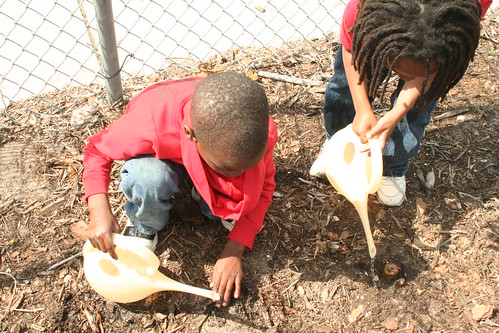
The purpose of our Edible Peace Patch is to connect children to their immediate environment, to teach them where their food comes from, to facilitate learning through doing. Through the magic of the garden the kids learn that broccoli does not manifest itself, pre-packaged in plastic, at the grocery store. Rather, they come to understand that a head of broccoli starts as a seed. With water, sunlight, nutrients, and their attention, the plant produces something that is edible and delicious. After becoming aware of this, I really do think that the kids become more knowledgeable and mindful of what they eat.

It is my hope that this simple notion will be planted deep within them where it can bloom and flourish in the years to come. When they grow older perhaps they will plant a garden of their own, shop at a local produce market, or simply eat more vegetables. However small the lasting effects of the Edible Peace Patch are, I know they will be overwhelmingly positive. Our current agricultural paradigm can only be transformed through a radical change in our nation’s mindset. I truly believe that this shift in outlook will occur through education, especially at a primary school level.
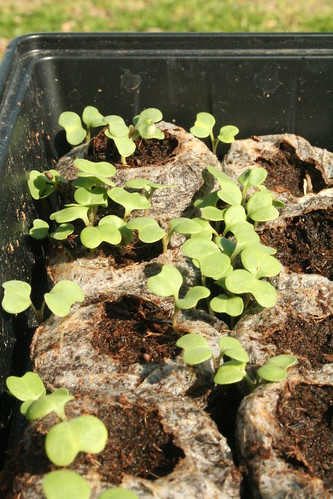
Today a group of first graders and I discovered an insect never-before seen in the garden, we discussed how honey was made, we inspected and drew a lone watermelon sprout.
 Will they realize in the future, that on this perfect day in February, they were participating in a food revolution?
Will they realize in the future, that on this perfect day in February, they were participating in a food revolution?
Monday, Monday...

Despite the gray, cloudy skies, it was a very successful day at the Edible Peace Patch! Sprouts are coming up faster than I can count, completely impervious to the recent spell of cold weather that has been plaguing sunny St. Pete. We’ve got some really nice tomatoes started, they all seem to be doing very well and will be ready to be transplanted into the bed soon. It seems that our herbs in the mini-greenhouses could be ready to go at any moment. Our kale, Swiss chard, and all our different types of lettuce are doing better than ever.
 We had a lovely bunch of kids come out to the garden on Monday, starting with some really fun kindergarteners…or should I say, kindergardeners. They helped us out a bunch by helping us clear the trench of all the mulch that’s fallen into it over the past few months so that we could plant some wildflowers in amongst the towering sunflowers. We had them kneel down and help us remove the big wood chips with their hands. It was amazing to see what those tiny hands could do in twenty minutes, seeing as we had just about the entire trench cleared of mulch by the end of their visit. We had some time so we had them go ahead and plant the flower seeds in the area they had cleared. All the kids we have had have been so perceptive of what we are doing – even these young ones – that explaining why we are doing these activities has been easy. They seem to love to learn, and it becomes even more apparent as we continue to work with them at the Peace Patch.
We had a lovely bunch of kids come out to the garden on Monday, starting with some really fun kindergarteners…or should I say, kindergardeners. They helped us out a bunch by helping us clear the trench of all the mulch that’s fallen into it over the past few months so that we could plant some wildflowers in amongst the towering sunflowers. We had them kneel down and help us remove the big wood chips with their hands. It was amazing to see what those tiny hands could do in twenty minutes, seeing as we had just about the entire trench cleared of mulch by the end of their visit. We had some time so we had them go ahead and plant the flower seeds in the area they had cleared. All the kids we have had have been so perceptive of what we are doing – even these young ones – that explaining why we are doing these activities has been easy. They seem to love to learn, and it becomes even more apparent as we continue to work with them at the Peace Patch.
We had just a few second graders come out to the Patch during the second half of our shift, which made our job much easier and of course much more personal. We visited the bed that was designated to their class and counted bean sprouts (ten so far!) and compared them to the larger beans we’ve started in pots. It was great to be able to engage the students and ask them questions about their observations. The kids were really great at being scientists and using their observations to predict what will happen to the beans as they grow. We also talked a little bit about the other plants in the garden and what stage in their life cycles they are in now. We had a piece of aloe break off accidentally earlier that day, so we talked to the kids about succulent plants and the medicinal value of aloe. They also got to touch the gooey aloe insides, which I think they all enjoyed very much.
The coming weeks should be filled with excitement as we continue to plant and teach and welcome in the spring.
Saturday, February 20, 2010
Weeding and Waiting
 Our Edible Peace Patch Garden at Lakewood Elementary is full of so much potential in the form of so many seeds. A few of them have begun to poke their leaves through the soil, but most of them are waiting for a little bit more sun and warmth. It is looking a bit bare right now for the most part, but I know that wonderful things are on their way.
Our Edible Peace Patch Garden at Lakewood Elementary is full of so much potential in the form of so many seeds. A few of them have begun to poke their leaves through the soil, but most of them are waiting for a little bit more sun and warmth. It is looking a bit bare right now for the most part, but I know that wonderful things are on their way.Thursday, February 18, 2010
Cultivating

There's a startling beauty to a garden filled with children and young adults. For two weeks now we have been beginning our work. Eckerd students in pairs and triplets and quartets have been planting seeds, turning compost, pulling weeds, and watching the first hints of our future crop begin to show itself through the surface of the soil with a whole cross section of Lakewood Elementary students. Food seeds sprouting everywhere. Beans led the way three weeks ago (although the cold has kept them from growing very much), they were followed by a glut of tomatoes, some intentional some volunteer all over the garden. This week we can see carrots beginning to push skyward, and broccoli with their clover shaped calyx beginning to do the same. I'm not superstitious, but I believe that a whole row of okra seed popped and started their sprout in the hour that we visited with kids today.

Click on the photo. You can see the broccoli sprouting there. Today our science coordinator lent us a beautifully illustrated and lyrically written book about seeds, which we read to the kids. We planted more sunflower seeds in the trenches and we also put stakes around the watermelon mounds. Because of the cold, almost none of the seeds planted last week by today's classes have sprouted. I have a feeling that next week the story will be different. Pinellas County elementary science standards are focused on life cycles this semester, and so we find every opportunity (of which they are legion) to observe life cycle and life cycle processes in our garden. The kids are such keen observers.

This Edible Peace Patch is off to yet another meaningful semester. I flip through the log book covering a full year out here and remember and admire the hard work my own students have invested in this place, cultivating value and learning the practice of good ecological citizenship. I look forward to this crop with more pride than any that came before. We have struck a rhythm. This is working. I am grateful.
Sunflowers, Pineapple and Lettuce!
Wednesday is always the day where we see the fruits of our labor. Not just in the garden, but with the students. We, as the independent study group, spend Friday and Monday of the previous week devising lesson plans for the 3rd grade EBD class and the 5th grade classes. We develop these lessons to parallel the learning that is taking place in the classroom.
We arrived a little before 11am today to await the arrival of the 3rd grade class. They eagerly approached us, begging us to try one more taste of the lettuce, the same lettuce they tried and disliked just one week before. Taste buds do change and we learned today just how fast, when the students all exclaimed how much they loved the lettuce!! That was our first glimpse at the fruits of our labor slowly ripening.
The lesson today was focused on characterizing plants. We developed a worksheet that encouraged the students to observe three plants that are now in the garden (lettuce, pineapple, and sunflowers) and answer some questions about them. Most of the class went through the assignment with ease answering questions about what part of the plants do we eat, does it flower, does it have a fruit, etc. There was one question though that seemed to create a perplexed look on each of the students face. How do pineapple reproduce? When asked this question about the other plants, they were able to provide an immediate and correct answer, but the pineapple just stumped them. Honestly, this was not something that I knew prior to working at the Edible Peace Patch Garden. This garden not only cultivates food, but it cultivates and instills knowledge in every person that walks through it. After some brainstorming (with a very low attention span) we were able as a group to describe how pineapples are planted and how they reproduce. It was time for them to leave, but as they got in line we had them each tell us a characteristic of a plant. As they left they said how they couldn’t wait to come back out next week!
We had fifteen minutes before the next class was to arrive so we neatened up some of the garden beds and found Sophia’s sunglasses! We looked at the time and realized the 5th grade class was late. We waited around for a little while then went to look for them and no one was to be found. So unfortunately today, the 5th grade class didn’t get to label the parts of the plants in the garden, but luckily if the weather doesn’t get too cold again the plants will still be there to label next week!
In teaching about the characteristics of the plants, I became more aware of some of the characteristics of this garden. Not only does this garden foster experiential learning and growth of tangible produce, but it fosters the growth of us and the students.
Wednesday, February 17, 2010
Tuesday, February 16th, 2010
Monday, February 15, 2010
Week 2 commences



As the weather should be sweeter tonight, we think the starters can safely stay outside. Starting tomorrow, there are more peppers to be planted with the children. Sunflower seeds can also be planted in the bare spots of the trench, and the dead leaves should be pruned off the tall stalks. It's going to be a busy week, and hopefully with warmer weather we can start seeing the fruits of a labors in the form of tiny seedlings!
Friday, February 12, 2010
 he garden I realized how great its going to look.
he garden I realized how great its going to look.The best thing I think I like about the garden so far would have to be kale. Purple and green are my favorite colors. After some weeding through the wood chips and the beds it was time for Ms. McDevitt's class to come out. We introduced ourselves to the class and talked briefly of the rules and how a garden works. Surprisingly so many of these kids knew about how important gardens were.


Thursday, February 11, 2010
Chilly but Sunny
 Today was still pretty chilly but the sun was out so the kids were out as well. After a little work in the garden the air no longer felt chilly, and some of the kids were able to take their coats off. The morning groups planted bush beans and carrots, and they were so excited to be putting their own seeds in the ground and watering them. "I've tried growing food before but it never works," one boy said to me. I assured him that he would have better luck this time. The second graders also watered the other plants already growing, and even watered some soil that didn't have any seeds yet - but it can never hurt to practice your watering can skills.
Today was still pretty chilly but the sun was out so the kids were out as well. After a little work in the garden the air no longer felt chilly, and some of the kids were able to take their coats off. The morning groups planted bush beans and carrots, and they were so excited to be putting their own seeds in the ground and watering them. "I've tried growing food before but it never works," one boy said to me. I assured him that he would have better luck this time. The second graders also watered the other plants already growing, and even watered some soil that didn't have any seeds yet - but it can never hurt to practice your watering can skills.Some beginning-of-semester organization is still being straightened out, but as it is still only the first week in the garden, I'm sure things will be going smoothly very soon. Some more eggplants were put in starters, so we now have 32 eggplants in starters, which is how many we'll need for the semester.
With the first week coming to an end tomorrow, we have put almost everything in the ground. The garden still looks pretty "wintry" and barren, but there are a few sprouts coming
 up and within a week all the beds should be glowing with little green sprouts.
up and within a week all the beds should be glowing with little green sprouts.The kids seem excited to be out in the garden and we are excited to be learning with them. It is amazing to think what kinds of social changes might be instigated from gardens like these, and what general social awareness and consciousness organic learning has to offer.
Wednesday, February 10, 2010
Windy Wednesday

Already our first week is halfway over. How quickly the time flies when you're having fun. The patch was quite cold and gusty this morning, making the sunflowers' roots work overtime. Yet the sun was so bright one could easily underestimate the temperature and decide against wearing an extra layer (with dire consequences). So, the morning was mostly spent in the shed with the wind threatening to blow it over, making starter charts, accounting for seeds, and organizing our planting schedule. Sophia and Alex started 12 peppers in the tray with the herbs, checked in on all the beds, and weeded a bit in bed 1. We decided against watering, testing the moistness with a finger in the beds, and also because it was so cold. Compost was added to our huge piles, but without the necessary carbon ingredients, the food waste will not break down as efficiently. Perhaps it is time to go on a hunt for dead leaves, sticks, cardboard, and other dry materials so we can ensure there's a nutrient rich soil for next season.

Without a class during the morning shift and early dismissal today, our bare garden was fairly devoid of its favorite visitors - the children. However, the independent study group came out early afternoon and planted eggplant starters with their class. We are almost on schedule with starting our plants, we just need to plant some more eggplants, peppers, tomatoes, okra, and broccoli. Other than that, the crops currently growing are doing excellent; we could make a delicious salad out of our lettuce and arugula or steam up some kale and chard. I even found a volunteer nasturtium, my favorite flower, in the herb garden. So, as the week approaches the end, the garden is just about ready and waiting for the classes, and for the learning and growing that accompanies every trip to the patch.

Tuesday, February 9, 2010
A Peace Patch Homecoming

It has been over nine months since I have visited the Edible Peace Patch. The drive to Lakewood Elementary brought on feelings of anticipation and apprehension. I was nervous to speak to the kids and interact with them in the garden again. It was exciting to see the changes and additions to the peace patch put in place during fall semester. The sunflowers towered over me, much taller than they were last year. Both compost piles were huge and overflowing with rank, rotting vegetable scraps. Oh the smell of future soil. There is now a small aloe garden and a handful of monstrous pineapple plants, but I am sure you blog readers are already aware of this!


All of my anxiety about seeing the kids ended up being in vain thanks to a Florida February cold front. It drizzled, spat, and poured for my entire four hour shift at the garden. As a result of the unpredictable weather all four of our scheduled classes remained indoors. Tyler, Stephanie, Dylan, and myself divided our time in the garden between pulling weeds and escaping Mother Nature's cold, wet wrath. Despite the weather we managed to annihilate a sizable portion of the garden's sedge population. I was saddened by the children's absence from the garden but it felt so good to have my hands back in familiar dirt.

Although some may interpret today's weather as a bad omen, my incredible experience in the garden last year started the same way.
With a rainy day.
Monday, February 8, 2010
Here Comes the Sun!


What is really exciting about the garden this spring is the way the kids will be interacting with it. Not only will we be planting our usual variety of kale, swiss chard, herbs, okra, radishes, etc, but each second grade class will have their own half of a bed, where individual kids will plant their own beans and monitor their life cycles as they grow over the course of the semester. The project will give the kids a sense of ownership, which is really important, as well as a chance to really interact with the garden in a very hands-on way.

Today we had a kindergarten class come out and plant some watermelon seeds. The kids were really excited to plant their own seeds and water them. While they were in small groups we talked to them about what the watermelon and all other plants needed to grow. We also discussed a little about the nutrients in the soil and why it was important to have lots of nutrients in the soil. Once the seeds were in the ground, we asked them what they expected to see next week when they came back – most of them said something like, “watermelon that we can eat!” Of course, we explained that it would take a little while before the plants were big enough to produce fruit, and happily this information did not damper their spirits at all. When our second grade class came out today we gave them each a couple of beans to plant in their bed, and let them water them. Before they planted we talked with them about what they should expect to see over the life cycle of the plants, what they needed to grow, and how we were going to monitor them. We can’t wait for these kids to see what they can do with just a few seeds. It’s going to be a great spring!
Saturday, February 6, 2010
Sprouts and other delights.
 After a busy Winter Term, cleaning and supplementing and harvesting and picking, the Spring semester is here. The garden enters its second year. (Happy Birthday Edible Peace Patch!) We have learned some things and hope to have a unusually productive harvest in late April. Many of the seeds that have already gone into the ground, which includes beans and watermelon and tomatoes and sunflower, are the results of last years' crops. The soils with which we supplemented the raised beds, also the by-product of last year, the results of a healthy compost releasing a few more yards of soil.
After a busy Winter Term, cleaning and supplementing and harvesting and picking, the Spring semester is here. The garden enters its second year. (Happy Birthday Edible Peace Patch!) We have learned some things and hope to have a unusually productive harvest in late April. Many of the seeds that have already gone into the ground, which includes beans and watermelon and tomatoes and sunflower, are the results of last years' crops. The soils with which we supplemented the raised beds, also the by-product of last year, the results of a healthy compost releasing a few more yards of soil. 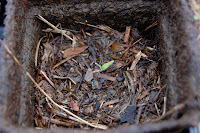
Next week the Lakewood students return. We have seeds to identify and plant, cardboard to be laid for weed control, and composts to be looked at and turned once again. The Edible Peace Patch garden will be growing beans and butterflies this Spring. The life science unit focuses on Life Cycles this spring and so we will plant beans and watch them grow (every second grade student will get their own plant). We are still looking for donations of butterfly weed. Our one butterfly plant seems to be heavily infested with orange mites and may or may not make it.

We built up some soil in the grounds just south of the pineapple plants, and planted six mounds of watermelon. We hope to have a healthy melon patch by late April as well. The hard frost that came in January seemed to knock the wind out of the pineapple plants, but on closer inspection this afternoon, I would say most of them are still alive. However, we plan to use these for lesson for the fifth graders about the effects of environment on plants. Each class will get to start a new plant next to the one that is recovering.
 The smaller pictures here are, in order from top to bottom, tomato, bush bean, nasturtium, all from garden seeds. The rains this morning drenched everything. But soon we will need to water on the weekend as well. The garden will be ready for students on Monday. We have posted recent photos from the garden at our flickr site. Everyone cannot wait for the new semester.
The smaller pictures here are, in order from top to bottom, tomato, bush bean, nasturtium, all from garden seeds. The rains this morning drenched everything. But soon we will need to water on the weekend as well. The garden will be ready for students on Monday. We have posted recent photos from the garden at our flickr site. Everyone cannot wait for the new semester.
